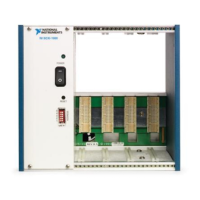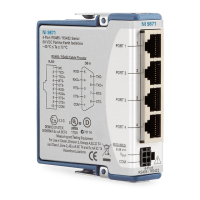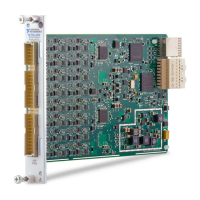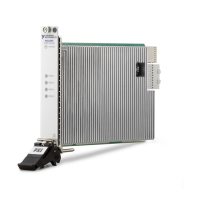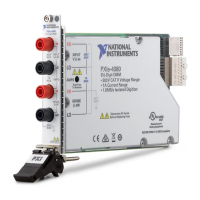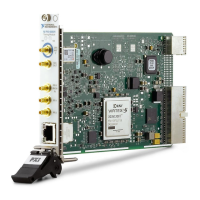Chapter 4 Connecting and Using Accessories and Transducers
Getting Started with SCXI 4-26 www.ni.com
When you select shunt calibration during a Wheatstone bridge strain
measurement, a 301 kΩ, 1% resistor internally shunts across the strain
gauge between the VEX+ and the CH+ terminals. This resistor is socketed
so you can change its value to meet your requirements. To permit the
system to settle, when you are either enabling or disabling the shunt
calibration resistor, you must wait 1 s if you have selected 4 Hz bandwidth
or wait 10 ms if you have selected 4 kHz bandwidth. Finally, to determine
the effect of the shunt resistor on your measurement, use the following
procedure.
Assuming a quarter-bridge strain-gauge configuration with a gauge factor
of GF = 2, the equivalent strain change the R
SCAL
shunting resistor
introduces is –199 µ
ε
. This is determined as follows:
1. Determine the change the shunt resistor causes using the following
formula:
where
V
EX
is the excitation voltage.
R
SCAL
is the shunting resistor.
R
g
is the nominal strain-gauge resistance value.
2. Using the appropriate strain-gauge formula and assuming that you
have no static voltage, determine the equivalent strain that the R
SCAL
resistor should produce. For example, if your SCXI system is
configured with R
SCAL
= 301 kΩ, a quarter-bridge 120 Ω strain gauge
with a gauge factor of GF = 2, VEX = 3.333 V, and R = 120 Ω,the
following result occurs:
V
change
= 0.3321 mV
Replacing the strained voltage with V
change
in the quarter-bridge strain
equation produces an equivalent –199 µε of change.
The current output channel is for transducers, such as thermistors and
RTDs, that need current excitation to operate properly. The current output
has a value of 1 mA and has a maximum permissible load of 5 kΩ.Ifyou
connect loads greater than 5 kΩ, the current source will lose regulation.
When connecting several loads that need current excitation, you have two
alternatives. The first approach is to connect them all in series (as long as
they do not exceed 5 kΩ total) and use the two-wire scan mode as shown in
change
V
EX
RR
SCAL
R
g
+()
R
g
R
SCAL
RR
SCAL
R
g
+()+
---------------------------------------------------------------
V
EX
2
---------–=
